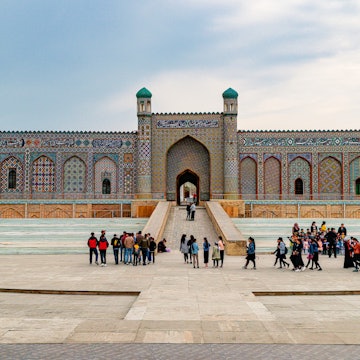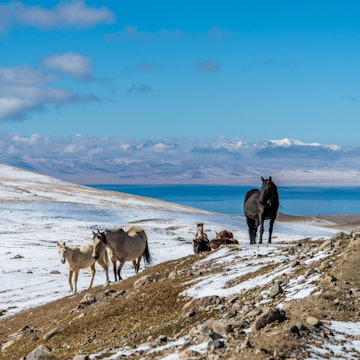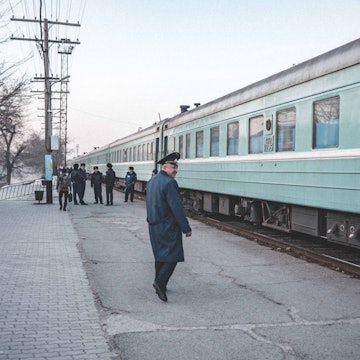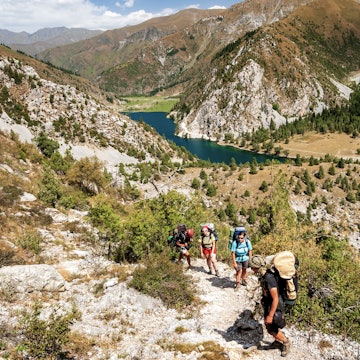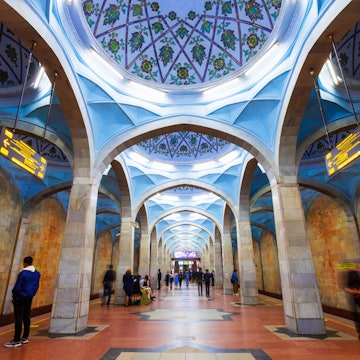

Tulpar Köl lake and Sary Mogul yurt camp in Kyrgyzstan. Cyrille Redor/Shutterstock
For a small country, mountainous Kyrgyzstan offers a surprising diversity of places to spend time as a visitor. Expect near-endless forests, rugged red desert canyons and the world’s second-largest alpine lake – and all that just in popular Issyk-Köl oblast (administrative division).
Visitors short on time often choose between either a northern or southern itinerary, perhaps including an overland border crossing to China, Tajikistan, Kazakhstan or Uzbekistan. Yet with a bit more time and a taste for adventure, there are months’ worth of activities to keep you busy in the Kyrgyz Republic. Here are eight places where you can start your exploring.

1. Son-Köl
Best high-altitude hangout
In a country packed with high alpine lakes, Son-Köl might be the most beautiful one, and a dreamy place to spend the day kicking back in a yurt camp. Along the shores of its 270 sq km surface, you can spot migratory birdlife, watch as shepherds tend to their herds or even take a dip in the frigid waters (situated over 3000m above sea level, the lake stays cold even in the middle of summer).
Son-Köl is one of very few high alpine lakes in Kyrgyzstan accessible by regular motorized transport. Yet if time and inclination permit, many tourists choose to arrive on horseback from the Jumgal region’s Kyzart Pass. Tours can be arranged with just a day’s notice in Kyrzart village or the town of Kochkor.
Planning tip: Travelers who just arrived to Kyrgyzstan may struggle with adjusting immediately to the altitude in Son-Köl. Count on a few acclimatization days before heading up there.

2. Osh
Best for Kyrgyz cuisine
At the eastern edge of the Fergana Valley and just a few kilometers from the border with Uzbekistan, the city of Osh has a unique cultural mix that makes it the best food destination in all of Kyrgyzstan. Centered on the bulk of Sulaiman Too – the mountain atop which the conqueror Babur is fabled to have lived in meditation, before going on to found the Mughal Dynasty in India – Osh has a population that includes ethic Kyrgyz, Uzbeks, Koreans and more. As these cultures have coexisted for centuries, so have their cuisines and ingredients mingled. This means that Osh today is home to much of the best (and cheapest) food in Kyrgyzstan.
Maida manty (tiny potato dumplings), laghman (noodles), samsa (samosas), plov (meaty Uzbek rice pilaf cooked in a large cauldron) and shashlyk (marinated meat and vegetables grilled on an open coal fire) are common across much of Central Asia – but you’ll rarely find tastier or more budget-friendly versions than in Osh.
Local tip: “Osh is like the whole of Central Asia in one place, a blend of nomadic and sedentary life, culture, history and cuisines. Combining the meat raised by nomads with the crops and the creativity of the sedentary people of Fergana Valley, Osh is at the apex of Central Asian cuisine.“ – Atabek Abdullaev, Owner and Guide, Best of Osh

3. Bishkek
Best base for a quick trip
Kyrgyzstan’s capital city, Bishkek has a booming dining and nightlife scene. Yet its handful of monuments and museums is no match for the attractions of the surrounding Chuy region. The 11th-century Burana Tower and nearby archaeological sites at Suyab and Navekat – Silk Road ruins that are collectively included on UNESCO’s World Heritage list – make for an excellent day trip from the city.
The nearby mountain valleys of Kegeti, Chunkurchak and popular Ala-Archa National Park are common hiking excursions for visitors who want a taste of Kyrgyzstan’s natural scenery but find themselves short on time to venture further afield.
Planning tip: Bishkek’s craft beer scene is surprisingly strong – stop by PIVO, Brewster, Save the Ales or Bez Variantov to sample a selection of local and regional beers and ciders, alongside a mix of international options.

4. Arslanbob
Best for walnuts and wandering
Local legends say it was at Arslanbob where Alexander the Great collected the walnuts that he would carry back to plant in Greece, first introducing the tree to Europe. While the science behind that claim is a little iffy, what’s not up for debate is that Arslanbob is surrounded by the world’s largest walnut forest, upon which much of the area’s commerce and tourism depend. October is the best time to visit, when travelers can join local families in decamping to the forests during the weeks of walnut harvest, sending seemingly endless bags of the nuts piled on the back of any available transport back to the village for collection.
Outside of the autumn, the village makes an excellent base for wandering in the forest, marvelous for quiet, reflective strolls outside of the harvest season; day hikes to two local waterfalls; or longer multiday hikes to nearby holy lakes. In winter, CBT Arslanbob organizes a ski challenge to promote snow sports within the community, with tourists most welcome to participate.

5. Karakol
Best for ecotourism
A small city below big mountains, Karakol has long been Kyrgyzstan’s most convenient base for ecotourism adventures of all kinds. In summer, hikes to Ak-Suu Arboretum or the extremely popular Ala-Köl lake and Altyn Arashan hot springs start just beyond the edge of the city. Further afield, almost every parallel valley from Jeti-Ögüz through to Boz Uchuk is a potential trailhead, with trekking passes linking them all together into the 100km Ak-Suu Transverse trek (one of the country’s absolute best).
In winter, nearby Karakol ski base is the top place for skiing in Kyrgyzstan, and one of the best in all of Central Asia. What’s more, in recent years local operators have reignited the Soviet legacy of cross-country skiing and snowshoe tours through the surrounding region.
No matter the season, Karakol’s multicultural identity makes it an excellent base for getting to know the region’s diverse foods. Local tourism management organization Destination Karakol organizes food tours that explore the culinary identities of local Dungan, Kyrgyz, Russian Cossack and Uyghur families – though your stomach will be hard-pressed to fit more than one of these into a day’s itinerary.
Beyond Karakol, the village of Jyrgalan makes an excellent alternate base for hiking and skiing. It’s less than two hours from the city on public transportation, and many visitors link the two places for a full trekking holiday.
Local tip: “Visit Karakol in late June, when wildflowers are in full bloom and snow still blankets the peaks, for incredible hiking and horseback riding through pristine valleys – before the trails become crowded.” Aidar Emilbek Uluu, Owner and Guide, Hiking Kyrgyzstan

6. Southern shore of Issyk-Köl
Best for beach time
While Issyk-Köl lake’s north shore sees all the traffic and most of the party vibes, it’s the quiet southern shore that draws in-the-know visitors, who can relax without the crowds. Running westward from Karakol is more than 200km of lakeshore dotted with small bays and long stretches of empty coastline that’s perfect for downtime – especially after finishing a hike in the Tian Shan mountains that loom just behind.
Issyk-Köl’s south shore is home to some of Kyrgyzstan’s best glamping yurt camps – letting guests trade the rugged high-pasture nomad lifestyle for beachfront properties with generous kitchens and laid-back vibes. The biggest cluster is around the village of Ton. Almaluu is one of the originals, set in a pretty apple orchard a little back from the shore, while Elestet is a newcomer positioning itself at the high end, with clifftop views out over the lake. Other good options are at Ak Tengir (near Tosor village) and Feel Nomad (beyond the Ak Sai canyon), both small camps set in quiet locations at the literal end of the road – perfect for a few days of down time.

7. Alay Valley
Best for epic views
Some of the best mountain panoramas in this exceedingly mountainous country are found in the southern Alay Valley. Administratively part of Osh oblast, the Alay feels a world apart from the big city (even though it’s only a couple of mountain passes away). The biggest draw is Peak Lenin: one of the world’s “easiest” 7000m mountains, it has a 7134m summit that’s popular among budding mountaineers and those training for bigger and more technical peaks.
Though such heights may be a touch out of reach for ordinary travelers, yurt camps alongside nearby Tulpar Köl’s 42 small lakes offer big views of the big peak without all that climbing. For a less technical adventure, head to the north side of the Alay Valley for the Heights of Alay trek, a five-day, 100km loop that crosses two big passes from which views of Peak Lenin are unbeatable.

8. Talas
Best for monuments
Tucked into the northwest of Kyrgyzstan and geographically (if not culturally) more Kazakh than Kyrgyz, unassuming Talas was the site of a major battle. In 751 CE, the armies of the Abbasid Caliphate defeated Tang Chinese forces in the Talas Valley, defining the edge of Chinese expansion and the cultural borders of modern Central Asia for hundreds of years to follow. Modern visitors more often travel here to visit a soldier from a different era: the Kyrgyz epic hero Manas, and his 14th-century mausoleum complex Manas Ordo.
Deeper into Talas, the birthplace of a modern Kyrgyz hero also attracts visitors. The author, diplomat and cultural icon Chinghiz Aitmatov (1928–2008) was born in the village of Sheker, where a small museum celebrates the oversize impact the writer had on Kyrgyz literature and culture.
Planning tip: Travelers planning to combine Kazakhstan and Kyrgyzstan into one overland itinerary can cross from Talas into the Kazakh city of Taraz without doubling back to Bishkek.








